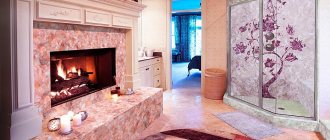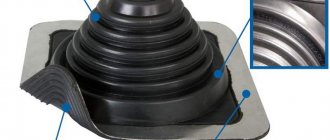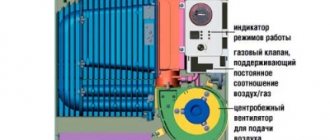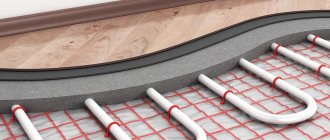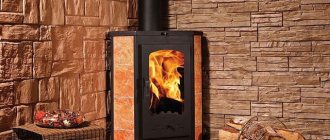Today, when furnishing their home, they very often decide to install a fireplace in it. After all, it acts not only as an addition to interior design, but also as a heating device.
In this article I will draw your attention to this type of fireplaces: gas. After all, they are rapidly conquering the market due to their main advantage - ease of installation and operation. A gas fireplace is a heating device with a living flame effect that uses gas as fuel. I will tell you about the main types of gas fireplaces and their features.
Gas fireplaces, their advantages and disadvantages
In order for the fireplace to delight you with cozy warmth on long cold evenings, it should be properly cared for. This means that you need to constantly monitor the combustion process, the moment of cleaning the firebox, etc.
Anyone who owns such a structure understands that its installation requires a considerable investment of effort and money. In addition, the development of a project and installation requires, first of all, coordination with the relevant authorities, and the plan of a country house should already have a prerequisite for arranging such a structure.
However, there is a simple solution to this problem. You can purchase a good model of gas fireplace and install it in your home.
They do not require special care, are easy to use and do not clog the room (with ash, firewood, soot). Apart from decorative models, gas ones can be used as regular heating appliances.
A gas fireplace is a heating device with a living flame effect, using natural gas (methane) or liquefied gas as fuel.
It makes sense to install a gas unit in apartments and country houses to which main gas is supplied.
Although it is possible to organize its operation on gas in cylinders. But in this case, you will need to equip a special room for storing gas containers, and the cylinders will have to be refilled from time to time (which is not very convenient). The combustion temperature of gas (500-650°C) is significantly lower than that of firewood.
Therefore, the requirements for heat resistance of the materials from which the fireplace is made are different. In addition, when burning gas fuel, very little soot is formed - mainly, it breaks down into carbon dioxide and water vapor.
Advantages:
- Much more environmentally friendly than wood-burning fireplaces, fewer hazardous substances enter the atmosphere.
- Gas fireplaces are cheaper in price than wood fireplaces, and their design is much simpler.
Fuel dosing is fully regulated by an automatic system, both electronic and mechanical. This means that, regardless of the degree of modernity of the model, a gas fireplace in an apartment does not require constant adjustments and intervention during operation.
- A live fire like a wood fire, but without ash and soot.
- The heating power of gas fireplaces can reach 8 kW.
Gas has a high specific heat of combustion, which explains the level of efficiency, which is incomparably higher than that of wood. In our case, it can exceed 80%.
- It is easy to use, it ignites quickly and does not require constant maintenance (throw in firewood, adjust the draft, or can be left unattended).
Flaws:
- To install a gas fireplace, permission from the relevant services (gas and fire) is required.
- A gas fireplace should ONLY be installed by a professional. Its first launch is accompanied by permits from the gas and fire departments. The owner, on his own initiative, cannot make any changes to the design or its operation.
- The fuel used is dangerous propane-butane or natural gas, so a fireplace with safety precautions or malfunctions can cause trouble.
Fireplaces are equipped with a pipe that acts as a chimney. If it is located far from the built-in ventilation duct, then a lot of work needs to be done, which must be agreed upon with the fire inspector.
Modern fireplaces are automated by electronic control systems, which means they require electricity. They are small, but installing a fireplace involves installing an outlet in close proximity, which increases the overall amount of work.
A gas fireplace can have an open or closed firebox - equipped with a heat-resistant glass door.
A unit with an open firebox resembles a fireplace using solid fuel. You can light it with matches without much difficulty, but there is also a danger of getting burned by its flame.
The glass door covering the front of the firebox plays a dual role: it protects the burner from contamination and protects users from possible burns due to careless handling.
Gas fireplaces with a closed combustion chamber use heat-resistant glass.
Gas is a flammable substance, but despite this, gas fireplaces are considered one of the safest devices. Thanks to a multi-level tracking system, any emergency situations will be prevented.
Infrared sensors are fireplace position sensors. They react if the device suddenly falls. To avoid causing a fire, the gas supply system is turned off.
A gas fireplace is a fairly powerful source of heat, so this unit can heat large areas of your home.
Gas fireplaces have lower exhaust requirements compared to wood fireplaces, which require a full chimney.
After all, the combustion products of natural gas are steam and carbon dioxide, and the temperature of the exhaust gases at the outlet is much lower. This also increases the appeal of a gas fireplace in the eyes of the modern consumer.
However, at the same time, you must understand that connecting a gas appliance involves additional work that must be carried out by specialized services. This procedure also requires documentation in accordance with local legislation. For many reasons, installation sites for gas equipment are limited by safety requirements.
The variety of models of gas fireplaces and fireplaces will allow you to realize any idea of implementing a modern, comfortable fireplace in your home.
You can install a fireplace using one of the existing methods:
- Floor method. This arrangement involves installing the firebox on the floor covering.
- Wall method. The firebox is hung on the wall and has a completely closed design with ventilation channels.
- Embedded method. The firebox is placed on a furnished base and covered with decorative elements.
- Street. The structure is installed outdoors, in a summer kitchen or gazebo.
Device
Despite the variety of models, their fundamental structure is almost the same. A gas fireplace consists of several structural elements:
- the firebox is open or closed, and its shape and size can be different;
- a smoke collector tapering upward, connected to the smoke exhaust duct;
- heat exchanger, to increase heat transfer it can have a ribbed shape;
- a gas burner installed in the lower part of the firebox and designed to supply gas from a main line or a cylinder;
- reflector for gas and flame distribution;
- false logs or coals made of heat-resistant ceramics that perform a decorative function;
- in closed models - heat-resistant glass;
- automation and control unit;
- in models designed to operate on propane-butane, a niche can be made for installing a cylinder.
The principle of operation of a gas fireplace is simple: when turned on by the regulator or from the remote control, gas supply and electric ignition begin, the gas ignites and burns in the set mode until the desired temperature in the room or in decorative mode is reached. Upon reaching the specified parameters, the power is reduced automatically or manually, depending on the capabilities of the model and the installed program.
Features of gas fireplaces
Gas fireplace equipment includes the following structural elements:
- A fireplace insert that decorates the room.
- A body made of cast iron or a special metal alloy.
- A high-power burner from which gas is supplied.
According to fire safety rules, such a device must have a high-quality fire-resistant lining, which, in addition, performs a decorative function.
There are fireboxes of different sizes and appearance, i.e. design, so everyone can choose the most suitable insert for their interior style for a gas fireplace.
To comply with fire safety measures, so as not to interfere with air circulation in the fireplace, the firebox must be lined. The cladding can be made of ceramics, artificial and natural stone or ceramic tiles, but the cladding material must have fire-resistant properties.
Inside the combustion chamber there is a firebox, necessarily lined with fireclay bricks, a gas burner, a reflector and a protective screen. All these elements are hidden behind artificial logs.
On the reflector screen, the combustion of fuel occurs, which comes out of the burner onto it. This screen consists of special frames that warm up quickly and release heat.
The reflector, in turn, helps accelerate the heat transfer process. The radiator located in the fireplace releases heat into the room by convection of hot air. The power depends on the number of radiator sections.
The gas fireplace burner is decorated with fireproof ceramic models. They create the impression that wood or coal is burning in the fireplace, and the flames are knocked out between the logs.
The fireplace body is usually cast iron, with possible finishing with stone, ceramics, metal, tempered glass.
The upper part forms a gas collector to which the chimney is connected. A ribbed radiator is installed on the gas collector - the main heating element.
Heat exchange is so efficient that heat loss is only 15%. And for solid fuel fireplaces - 50 - 70%.
The efficiency of a gas fireplace is achieved due to the optimal fuel combustion mode and the special design of the body, which allows the maximum heat from the gases to be transferred to the room air.
Chimneys for gas fireplaces are made of special stainless steel, since combustion produces a lot of water vapor saturated with acids.
Chimneys are enclosed with thermal insulation material that is resistant to heat and oxidation, which prevents water from condensing directly in their lower part.
The upper part of the fireplace is the smoke collector, which passes through the smoke exhaust channel into the chimney itself. The smoke collector has the shape of an accordion, which increases the heat transfer of a gas fireplace.
The fireplace chimney is designed to create draft and remove combustion products outside the room. During the combustion of gas, carbon dioxide and water vapor are released, which have a detrimental effect on the chimney. For this reason, it is made of a heat-resistant material that also has water-repellent properties; steel is most often used for this.
The power of gas fireplaces is usually in the range of 7-12 kW, which is quite a lot, enough to heat the “floor of the house”. At the same time, fuel consumption in heating mode can reach 500 g per hour. And in the flame simulation mode – 180 g per hour, which is comparable to the consumption of a gas stove burner.
The gas device is controlled by a microprocessor. The fireplace is equipped with temperature sensors, so you can set the room to warm up to a certain temperature. Other sensors monitor draft, gas flow and pressure, optimal combustion, etc. In case of violations, the fireplace will be turned off; the safety of operation of this household appliance is guaranteed by the manufacturer.
Gas fireplaces are produced both for main gas and for liquefied propane in cylinders, and this is an option for a remote dacha.
In any case, the gas unit is connected by the gas service master, according to the gas supply project, for which the relevant documents are issued.
But before purchasing and installing a fireplace, you need to obtain permission to install it. This is easier for a home or cottage, but problematic for an apartment.
Manufacturers
When purchasing gas equipment, it is important to choose not only a functional, but also a reliable unit, and the buyer usually places the greatest trust in trusted companies. Below is a brief overview of them.
Cheminees Philippe, France
A popular French company, time-tested, producing a wide range of models of any functionality, design and price. The line of this manufacturer, Cheminees Diffusion, allows you to choose an inexpensive but reliable fireplace that can become a decoration and effectively heat any home or cottage.
Gutbrod Keramik, Germany
The peculiarity of this company is its specialization in gas stoves designed for heating rooms. The history of the development and production of stoves from this company goes back one and a half centuries; these models are time-tested and have increased heat transfer, pleasant design and high efficiency.
Waco&Co, Belgium
The company, specializing in the production of wood-burning and gas fireplaces, including exclusive ones, is able to satisfy the most demanding needs. The company relies on original design, finishing with expensive materials, while at the same time their products are reliable and functional.
Element4, Netherlands
Gas fireplaces from this manufacturer are distinguished by their laconicism and modern design, the emphasis is on the beauty of a live fire, and simple finishing and a high level of automation make it possible to reduce firebox maintenance to a minimum. Thanks to a minimum of expensive finishing, heating devices from this manufacturer are affordable.
Gas fireplace safety
Modern gas fireplaces are equipped with several automatic safety systems:
- Checking gas pressure.
The gas supply system provides and maintains constant pressure, and the built-in sensor monitors the process and automatically stops the gas supply in case of any violations.
- Air analyzers.
Another sensor is atmospheric. They constantly check the condition of the air in the room, determining the level of carbon dioxide formed during combustion, and if the norm is exceeded, they automatically issue a command to turn off the gas supply.
- Infrared sensors.
Their task is to monitor the position of the fireplace. If for some reason it unexpectedly tips over, infrared sensors will detect this and instantly stop the fireplace from working.
Gas fireplaces without chimney
The principle of operation of chimneyless fireplaces is the complete combustion of fuel, which leads to the absence of combustion products.
They are used as decorative elements and are manufactured in several modifications:
- Floor-standing fireplaces for a home on gas without a chimney look like a regular island fireplace.
A small gas cylinder is installed inside the case, the capacity of which is sufficient for full operation for several hours.
Floor-standing models are often equipped with wheels or can simply be moved to any convenient place. A convenient option because it does not require special tricks during installation and can be used even outdoors, verandas and cafes.
- Hanging and built-in fireplaces. Easy to install outdoors, creating a cozy and comfortable atmosphere.
Installing stationary built-in devices is more difficult, but the result is more aesthetically pleasing. The front panel of the fireplace is flush with the wall, the device does not hide the space of the room. You can also “hide” gas supply lines in the wall. In addition, such a fireplace can be decorated with a wall, then the flame can be observed from two or even three sides.
The models are completely safe; no toxic combustion products are released during combustion. To install a chimneyless fireplace, there is no need to obtain permits. To ensure proper operation, the room should be ventilated before turning on the device.
Advantages of gas fireplaces without a chimney
When choosing, most buyers are guided by the ratio of positive and negative properties of heating equipment.
Comparing the pros and cons, they make a certain choice and make a purchase.
Gas fireplaces for apartments without a chimney have a number of distinctive features:
- Quick ignition.
While wood or charcoal takes a long time to ignite effectively, the gaseous mixture ignites immediately and within minutes you will feel the temperature in the room increase.
- Additional properties.
Many models are supplemented with devices that simplify the operation process. For example, a thermostat can control the level of heat generated to optimize fuel consumption.
- Simplified operation.
Installation requires a minimum of effort and time; you do not have to constantly move logs, chop wood and look for coal.
- Environmental Safety.
Gas-powered structures emit minimal pollutants into the atmosphere. An alternative option may be to use biogas obtained from waste processing - when burned, it emits significantly less carbon dioxide.
Is it profitable or unprofitable to heat a dacha with bottled gas?
An approximate estimate of the cost of heating with bottled gas can be determined from the following calculations:
- The calorific value of a cubic meter of firewood with 12% humidity is on average 2300-2500 kW/h, while for propane this characteristic is 6710 kW/h;
- The efficiency of a gas fireplace is 97%, the wood-burning version provides no more than 25-27%;
- The cost of a cubic meter of firewood is 1,600 rubles; for propane, the price of a cubic meter will be 19 thousand rubles.
As a result of the most approximate comparison, it turns out that to obtain an equivalent amount of heat from wood and propane, you will need 1.2 and 1.1 rubles, respectively. It turns out that heating using bottled gas will cost at least no more than wood in terms of fuel costs. If you take into account the transportation tariff and losses when cutting wood, then bottled gas may turn out to be more profitable.
Gas fireplaces on a cylinder
When installing, the first thing you need to do is decide on the location of the fireplace, make a marking of where exactly the structure will be placed, and only then get down to business.
And although gas cylinder fireplaces are modern safe designs, precautions must be observed.
There are certain rules for installing a gas fireplace that must be strictly followed.
Remember that by neglecting these rules, you risk not only your own health, but also that of your loved ones. After all, due to carelessness and negligence, a fire, explosion, or, at best, equipment damage can occur.
Basic Rules:
- A gas fireplace or stove should be mounted exclusively on a stable, flat surface. Such a surface must be made of fire-resistant materials or can be lined with fire-resistant tiles.
- The load-bearing floors must support the weight of the fireplace. The bearing capacity of concrete slabs is 750 kg/m2, for wooden floors - no more than 300 kg/m2. If the load-bearing capacity is less than the mass of the heating device, then it should be distributed over the entire surface, increasing the support area.
- Remove all flammable furniture and structures from the heating surface of the fireplace to a safe distance. As a rule, this is indicated in the device passport.
If the wall is not insulated, a distance of 60 cm is considered safe, for a ceiling - 130 cm. If for some reason you need to reduce this distance, this can be done by using sheet steel cladding.
The steel sheet is laid on top of a layer of mineral or basalt wool or asbestos, the thickness of which must be at least 8 mm. It is worth noting that asbestos material itself is not environmentally friendly, and for this reason its use in residential premises is not advisable.
- The gas main is supplied through metal pipes, as well as special gas fittings. This type of work must be entrusted to specialists. Only gas cylinders are allowed to be connected by yourself, but if you are not confident in your abilities, do not take risks, invite a specialist.
- Gas fireplaces using bottled gas without a chimney are not permitted.
The chimney for removing processed gases must be made of resistant materials. Ceramic and stainless steel chimneys are suitable; they will be resistant to acids.
They mainly buy sandwich chimneys made of stainless steel, which have high corrosion resistance and good thermal insulation. Prefabricated ceramic chimneys are also reliable, but they are more expensive.
In addition, you can use a coaxial chimney with a built-in recuperator and air duct.
- For combustion efficiency to be high, air must flow into the firebox without obstruction. The intake can occur either from the room through air ducts or through special air channels in the chimney system.
- Make sure that the room with the fireplace is always ventilated. Fireplace models with an open firebox should be placed so that the flame is not directly exposed to air.
- When installing a built-in type of firebox in a casing, make channels in it in advance so that air can circulate freely in both its upper and lower parts. The convection flow must pass freely between the casing and the heating chamber, and at the same time be able to remove heat from its walls.
Making it yourself step by step
You can assemble a practical and safe gas fireplace for a private home yourself. The main element is a gas burner. It must be installed in a metal structure (stainless or chrome).
The control valve is connected using a flexible hose to the fuel source (cylinder or pipe). To assemble the structure (base), you can use refractory bricks. The outer part can be finished as usual, since it will not heat up too much. A special compound (fireproof mixture) is used for bonding. At the final stage, the chimney is installed.
To ensure that in the event of extinguishing, the fuel supply is turned off and combustion stops simultaneously, you need to install a burner with a built-in thermostatic valve.
You can make a fireplace using a cast iron bowl or drum from an old washing machine. You will also need a metal rim from a wheel or thin strips of iron that will need to be bent to shape. Basic manufacturing steps:
- The rim is cut to the required size (the sheets are bent).
- The rim elements are connected to the supports by welding.
- Install the drum of the machine inside.
- Secure with metal elements.
- Install a gas burner inside.
- Connect the hoses to it.
This version of the fireplace can be used for installation outdoors.
